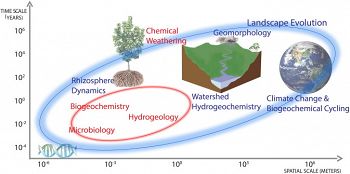Li et al., 2017
Expanding the role of reactive transport models in critical zone processes
Li Li, Kate Maher, Alexis Navarre-Sitchler, Jenny Druhan, Christof Meile, Corey Lawrence, Joel Moore, Julia Perdrial, Pamela Sullivan, Aaron Thompson, Lixin Jin, Edward W. Bolton, Susan L. Brantley, William E. Dietrich, K. Ulrich Mayer, Carl I. Steefel, Albert Valocchi, John Zachara, Benjamin Kocar, Jennifer Mcintosh, Benjamin M. Tutolo, Mukesh Kumar, Eric Sonnenthal, Chen Bao, Joe Beisman (2017)
Earth-Science Reviews, 165:280-301 Cross-CZO
-
Shale Hills, INVESTIGATOR
-
National, ADVISORY BOARD
-
Catalina-Jemez, Luquillo, Reynolds, INVESTIGATOR
-
Calhoun, Shale Hills, INVESTIGATOR, COLLABORATOR
-
Calhoun, Luquillo, INVESTIGATOR, COLLABORATOR
-
Shale Hills, INVESTIGATOR, COLLABORATOR
-
National, Eel, Luquillo, Shale Hills, INVESTIGATOR, COLLABORATOR
-
Eel, INVESTIGATOR
-
Shale Hills, INVESTIGATOR
-
Catalina-Jemez, INVESTIGATOR
-
Calhoun, INVESTIGATOR
-
Shale Hills, GRAD STUDENT
Abstract
Reactive transport models (RTMs) are being used currently and will be used in the future at a wide range of temporal and spatial scales. The red color indicates disciplines where RTMs have been used most commonly in the past three decades. The blue color reflects potential opportunities for further RTM development and application.
Models test our understanding of processes and can reach beyond the spatial and temporal scales of measurements. Multi-component Reactive Transport Models (RTMs), initially developed more than three decades ago, have been used extensively to explore the interactions of geothermal, hydrologic, geochemical, and geobiological processes in subsurface systems. Driven by extensive data sets now available from intensive measurement efforts, there is a pressing need to couple RTMs with other community models to explore non-linear interactions among the atmosphere, hydrosphere, biosphere, and geosphere. Here we briefly review the history of RTM development, summarize the current state of RTM approaches, and identify new research directions, opportunities, and infrastructure needs to broaden the use of RTMs. In particular, we envision the expanded use of RTMs in advancing process understanding in the Critical Zone, the veneer of the Earth that extends from the top of vegetation to the bottom of groundwater. We argue that, although parsimonious models are essential at larger scales, process-based models offer tools to explore the highly nonlinear coupling that characterizes natural systems. We present seven testable hypotheses that emphasize the unique capabilities of process-based RTMs for (1) elucidating chemical weathering and its physical and biogeochemical drivers; (2) understanding the interactions among roots, micro-organisms, carbon, water, and minerals in the rhizosphere; (3) assessing the effects of heterogeneity across spatial and temporal scales; and (4) integrating the vast quantity of novel data, including “omics” data (genomics, transcriptomics, proteomics, metabolomics), elemental concentration and speciation data, and isotope data into our understanding of complex earth surface systems. With strong support from data-driven sciences, we are now in an exciting era where integration of RTM framework into other community models will facilitate process understanding across disciplines and across scales.
Citation
Li Li, Kate Maher, Alexis Navarre-Sitchler, Jenny Druhan, Christof Meile, Corey Lawrence, Joel Moore, Julia Perdrial, Pamela Sullivan, Aaron Thompson, Lixin Jin, Edward W. Bolton, Susan L. Brantley, William E. Dietrich, K. Ulrich Mayer, Carl I. Steefel, Albert Valocchi, John Zachara, Benjamin Kocar, Jennifer Mcintosh, Benjamin M. Tutolo, Mukesh Kumar, Eric Sonnenthal, Chen Bao, Joe Beisman (2017): Expanding the role of reactive transport models in critical zone processes. Earth-Science Reviews, 165:280-301. DOI: 10.1016/j.earscirev.2016.09.001
Explore Further













